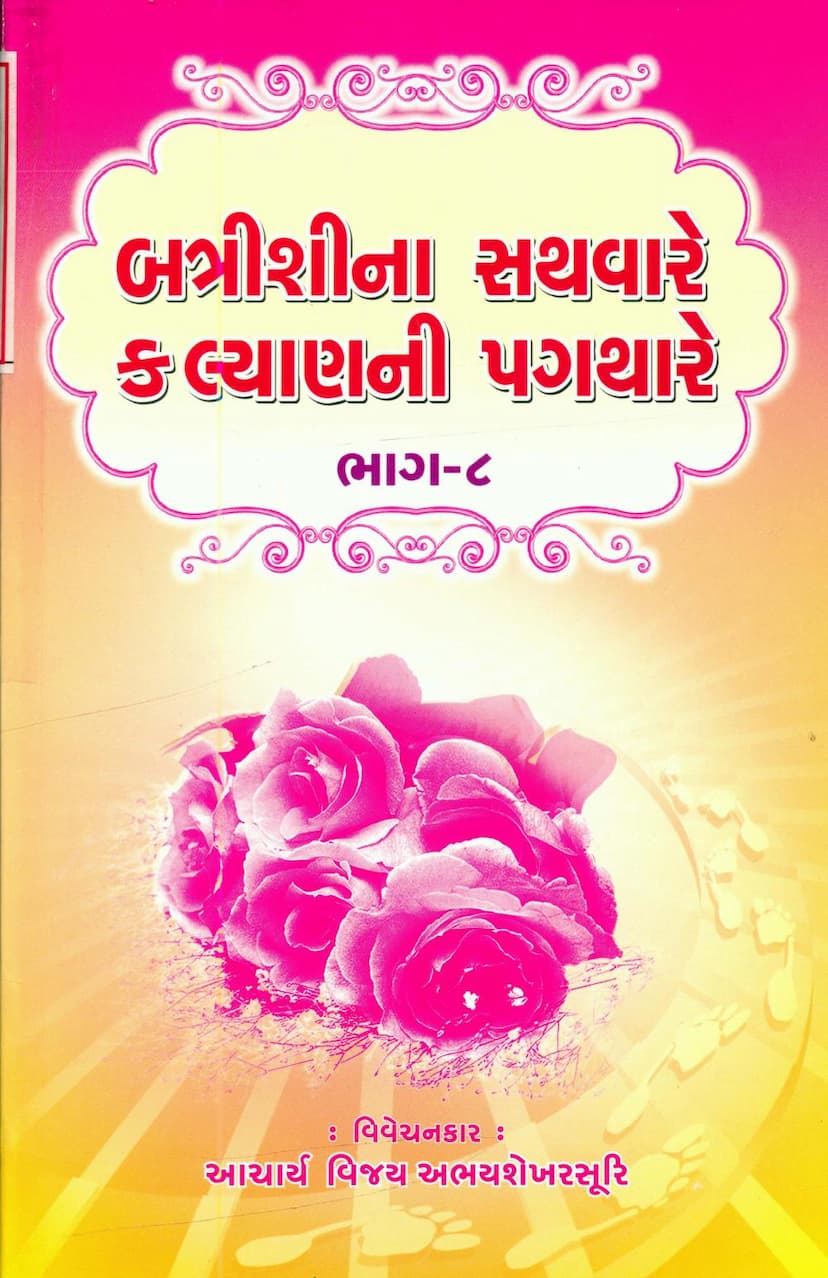Battrishina Sathware Kalyanni Pagthare Part 08
Added to library: September 1, 2025
Loading image...

Summary
This Jain text, "Battrishina Sathware Kalyanni Pagthare Part 08," is the eighth volume in a series based on the "Dwātrinśad Dwātrinśikā" by Mahopādhyāya Shrimad Yashovijayji Maharaj. Authored by Acharya Vijay Abhay Shekharsuri, it offers a popular commentary on the 18th and 19th "Bātrishis" (chapters or sections) of the original work, specifically covering topics related to Yoga.
Key themes and content discussed in this volume include:
- Introduction and Context: The book is published by Divyadarshan Trust and is dedicated to the spiritual welfare of the Jain community. It highlights Acharya Vijay Abhay Shekharsuri's skill in making profound scriptural topics accessible to the general public.
- Yoga and its Classifications: The volume delves into the philosophical concept of Yoga as described in Jain scriptures. It explains that Yoga is the primary means to liberation. The text then elaborates on five specific types of Yoga:
- Adhyātmayoga: This involves contemplating the true nature of soul and other substances with attitudes of friendliness (maitri), compassion (karuna), joy (mudita), and equanimity (upeksha). It emphasizes aligning actions with righteous principles and avoiding attachment or aversion. The text details the four types of Maitri, Karuna, Mudita, and Upeksha bhavanas.
- Bhāvanāyoga: This is described as the continuous and diligent practice of Adhyātmayoga, involving the suppression of mental modifications. It builds upon the foundation of Adhyātmayoga by intensifying the practice and aiming for greater concentration.
- Dhyanayoga: This involves focused meditation on a single subject without distraction, leading to mental stillness. The text outlines the importance of avoiding eight specific obstacles to meditation, such as fatigue and distraction.
- Samatāyoga: This refers to maintaining equanimity and a balanced perspective towards all experiences, avoiding extreme attachment or aversion. It emphasizes seeing all situations with impartiality.
- Vr̥ttisaṅkṣayayoga: This involves the gradual cessation of mental and physical activities that lead to the cycle of birth and death. It culminates in the attainment of Kevala Jnana (omniscience) and the state of Atyogi (one liberated from all karmic bonds).
- Interrelation of Yogic Practices: The text explains how these different forms of Yoga are interconnected and build upon each other. For example, diligent practice of Adhyātmayoga leads to Bhāvanāyoga, which in turn cultivates Dhyanayoga and Samatāyoga, ultimately leading to Vr̥ttisaṅkṣayayoga.
- Discussion on various Yogas: The volume further categorizes Yoga into five types: Sthāna Yoga (posture), Urṇa Yoga (vocalization/chanting), Artha Yoga (contemplation of meaning), Ālambana Yoga (meditation with an object), and Anālambana Yoga (meditation without an object). It also explores the intricate relationship between Adhyātmayoga and these other classifications.
- The Role of Virtue and Conduct: The importance of virtuous conduct, control over senses and mind, and detachment from worldly desires are highlighted as essential components for progressing in Yoga.
- Qualities of a Yogi: The text describes the characteristics of a true yogi, including detachment, equanimity, wisdom, and unwavering devotion to the path of liberation.
- Stages of Spiritual Progress: The commentary implicitly touches upon the spiritual journey, referencing different stages of spiritual development (Guṇasthāna) and how Yoga practices are relevant at each stage.
- The Ultimate Goal: The ultimate aim of these yogic practices is presented as liberation (Moksha) from the cycle of birth and death, achieved through the purification of the soul and the attainment of omniscience.
Key Concepts Explained:
- Maitri, Karuna, Mudita, Upeksha Bhavanas: These are central to Adhyātmayoga, representing attitudes of friendliness, compassion, appreciative joy, and equanimity towards all beings.
- The importance of Righteous Conduct (Auciya Pālan): Avoiding improper actions and adhering to moral principles is crucial for spiritual progress and the practice of Yoga.
- The Role of Knowledge and Action (Jnāna-Kriyābhyāṁ Mokṣaḥ): Both spiritual knowledge (Shruta) and righteous conduct (Śīla) are necessary for achieving liberation.
- The Path to Yoga: The text emphasizes that the journey towards Yoga involves continuous effort, self-discipline, and a deep understanding of spiritual principles.
- The distinction between superficial practices and true Yoga: The book likely stresses that mere outward observance without inner transformation and understanding is not true Yoga.
In essence, this volume serves as a guide for Jains seeking spiritual advancement through the understanding and practice of Yoga, as expounded in classical Jain literature, making complex teachings accessible through clear and insightful commentary.